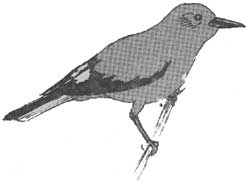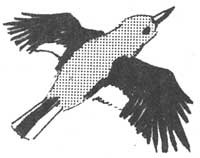CLARK'S NUTCRACKER, Nucifraga columbiana
Monday Night Football has Howard Cossel; Mt. Rainier has Clark's
Nutcracker. They're a lot alike, Clark and Howard.
For example, both are associated with persons of fame. Howard was
more or less discovered with Muhammed Ali, and his star rose alongside
the boxer's. Ah, but Clark Snutcracker's (that's the way most people
pronounce it, isn't it?) connections are even more famous. He was first
described by the illustrious William Clark (near present-day Salmon
City, Idaho, on August 22, 1805) during the celebrated Lewis and Clark
expedition. The well-known American ornithologist Alexander Wilson named
him and wrote him up -- celebrity stuff indeed, if you're a bird.

Indeed, Clark is way ahead of Howard as regards celebrity status. No
one has named any thing after Howard as yet (the Largemouth Bass was
named centuries before Cosell came along), but the Camp Bird Mine near
Ouray, Colorado, bears one of his alternative names. He's also called
Meat Bird because he eats meat, both fresh and carrion, moreso than do
his jay and crow relatives.
Celebrity status requires that the subject be in the public eye. Most
of the year, Clark's Nutcracker lives at high elevations in the western
mountains, usually near treeline. But between nesting seasons, flocks of
the bird range widely, invading new areas, descending the forested
slopes to lower elevations. The bird can be seen some time or other in
just about any place that's thickly wooded. And there's nothing reticent
about either Clark or Howard. Both are bold and noisy and neither minds
in the least being seen.
If you're a celebrity, it always helps to get the jump on the
competition. Clark does. In February and March, when other birds are
just starting to think about wending their way to nesting grounds, Clark
and his wife are already hard at work producing the year's new brood.
The three or four eggs, pale and usually speckled, are nurtured in a
well-built nest high in the trees. By late April, when other birds are
just starting, the young nutcrackers are fledged and on their own.
But February is still the dead of winter in the high country. So what
do nutcrackers eat and feed their young? The bird is adept at cracking
open pine and fir cones to extract the protein-rich seeds. Tree seeds
from cones above the snow form almost all the bird's diet during part of
the year.

Come spring, the nutcracker varies the menu with insects. Summer brings berries
and seeds as well as bugs (and tourists; another name is Camp Robber). Like its
jay and crow relatives, the nutcracker is an opportunist, eating whatever is
handy.
Howard's physical appearance is unique and easily caricatured. So is
Clark's. In fact, Clark himself is something of a caricature; he looks
like an overweight mockingbird with a stubby tail. His battleship grey
colour resembles the Grey Jay's somewhat, but the Grey Jay has plain
dark wings. Clark's crisp black wings sport flashy white patches as he
flies.
And that voice...! Howard's is unique, but moreso Clark's. Once
you've heard it you'll never forget that grating, nasal Kraaa! Kraaa!
Our sportscasting friend is merely the voice of a dozen sporting events
annually. But as the loon is the voice of the northern lakes, so is
Clark the voice of our whole vast high country.
Eat your heart out, Howard.
Sandy Dengler

